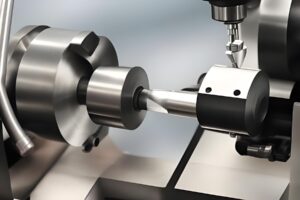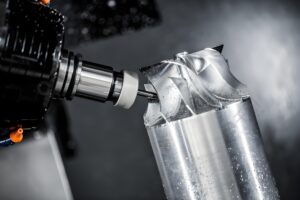In the rapid development of modern manufacturing, CNC (computer numerical control) technology is undoubtedly one of the important forces driving the industrial revolution. Among them, CNC milling, as the most commonly used processing method, is favored by various industries for its high precision, high efficiency and flexibility. From aerospace to automobile manufacturing, from mold production to medical devices, CNC milling is everywhere and has become a key means to improve product quality and production efficiency.
What is CNC milling?
CNC milling is a subtractive manufacturing process in which computer-controlled cutting tools gradually remove material from the workpiece to create the desired shape or object. This process is achieved by using a machine called a CNC milling machine or CNC mill. CNC milling technology uses pre-written computer programs to precisely control the movement and cutting path of the tool to ensure high-precision and consistent processing results.
In the CNC milling process, the workpiece is usually fixed on the worktable of the machine tool, and the tool is cut by rotational motion. Depending on the processing requirements, the tool can move along multiple axes to achieve the processing of complex three-dimensional shapes and geometric features. CNC milling is widely used in various industries, including aerospace, automotive manufacturing, electronics industry, medical devices, etc., because it can quickly and efficiently produce high-precision, high-quality parts.

How CNC Milling Works
Before the incorporation of CNC, the controls in the milling machine were performed manually. This gave a lot of room for error. The final product appeared in the machinist’s mind or vision, similar to the way an artist draws a picture. However, with the addition of CNC, milling became a highly accurate and precise process involving a number of steps. There are four sequential steps involved in creating a CNC milled part:
1.Design 3D Model
During the design 3D model stage, the three-dimensional shape of the part is created using computer-aided design (CAD) software. Design engineers draw the model based on functional requirements, refining every detail. The software allows for adjustments to size, shape, and features to ensure that the design is accurate and correct. The design process needs to consider processing feasibility and material properties in order to produce a model suitable for CNC milling. Once completed, the model can be exported to a variety of file formats, ready for further processing.
2.Convert the model to machine code
Import the designed 3D model into the CAM software to generate the machine code (G-code) for the CNC milling machine. In the CAM software, set the machining parameters such as tool path, feed rate and spindle speed, and then convert these settings into machine code through the software. These codes instruct the CNC milling machine how to move the tool and workpiece to ensure the machining process is accurate and error-free. Finally, the generated G-code is transmitted to the control system of the CNC machine tool to perform the actual machining task.
3.Set up the CNC milling machine
When setting up the milling machine, first select the appropriate tool and install it on the spindle. Next, firmly fix the workpiece material on the table to ensure that it is stable and motionless. Then, perform zero point setting to accurately calibrate the position of the workpiece so that the tool can process according to the predetermined path. Finally, check all settings and connections to ensure that the equipment is operating properly.
4.Perform actual milling
During the actual milling process, the CNC milling machine starts cutting according to the preset program and tool path. The tool gradually removes material from the surface of the workpiece at the set speed and feed rate under the rotation of the spindle. The operator monitors the machining process in real time to ensure the accuracy of the tool and workpiece position, while checking for abnormal conditions such as vibration or noise. Throughout the process, the cooling system continuously sprays cutting fluid to keep the tool and workpiece cool to improve machining accuracy and extend tool life.
Materials that can be CNC milled
1.Metal materials
Common metal materials in CNC milling include aluminum, steel, and titanium. Aluminum is widely used in the aerospace and automotive industries due to its light weight, moderate strength, easy processing, and good thermal conductivity. Steel has high strength and wear resistance and is suitable for manufacturing mechanical parts and structural parts. Titanium is often used in high-performance applications such as medical implants and aerospace engine components due to its excellent strength-to-weight ratio and corrosion resistance. These metal materials require the selection of appropriate cutting parameters and tools to ensure machining quality and tool life.

2.Plastic materials
CNC milling is also suitable for a variety of plastic materials, including ABS, polycarbonate (PC), and polyoxymethylene (POM). ABS has good strength and toughness and is often used to manufacture housings and structural parts. Polycarbonate is widely used in optical components and protective covers due to its high transparency and impact resistance. Polyoxymethylene is suitable for the processing of precision gears and bearing seats due to its high rigidity and low friction. When processing plastic materials, lower cutting speeds and feed rates are usually used to prevent thermal deformation and melting of materials.
Advantages and applications of CNC milling
1.High precision
CNC milling technology can achieve micron-level processing accuracy. Through computer control, the movement of the tool and the cutting path can be precisely controlled to ensure the size and shape consistency of the processed parts.
Application: In the aerospace industry, CNC milling is used to manufacture aircraft structural parts and engine components, which have extremely high requirements for precision. In addition, high-precision processing is also required in medical device manufacturing to ensure the function and safety of the equipment.
2.High efficiency
CNC milling can achieve high-speed processing and automated production. The machine tool can complete a large number of processing tasks within a set time, improve production efficiency, and shorten the production cycle.
Application: In the automotive manufacturing industry, CNC milling is used to produce engine parts, gearbox parts, etc. Efficient processing can quickly respond to market demand and improve the overall efficiency of the production line.
3.Flexibility
Through programming, CNC milling machines can quickly switch processing tasks to adapt to different product designs. This flexibility makes it very suitable for small-batch, multi-variety production needs.
Application: In the field of mold manufacturing, CNC milling can quickly adjust processing parameters and produce different types of molds, such as injection molds and stamping molds, to meet diverse customer needs.

4.Stability
The processing process of CNC milling is less affected by human factors and can ensure the consistency and stability of processing quality. The automated operation of the equipment reduces human errors and ensures product consistency.
Application: In the electronics industry, CNC milling is used to process precision electronic components and connectors, and stable processing quality is essential to ensure the performance and reliability of electronic products.
5.Versatility
CNC milling is capable of performing many types of processing, including plane milling, slot milling, hole processing, and contour processing. This enables it to cope with a variety of complex processing tasks.
Application: In the field of mechanical manufacturing, CNC milling is used to process complex mechanical parts such as gears, brackets and housings, which usually have complex geometries and processing requirements.
Conclusion
CNC milling technology plays a vital role in modern manufacturing, meeting various industrial needs with its excellent precision, efficiency and flexibility. From complex aerospace components to precision medical devices, CNC milling technology provides reliable solutions for all walks of life with its powerful processing capabilities and wide applicability. Despite some challenges, such as high equipment costs and programming complexity, the future prospects of CNC milling are still bright with the continuous advancement and innovation of technology.
The continuous development of intelligent, composite processing and environmental protection technology will further enhance the processing capabilities and sustainability of CNC milling. We look forward to more breakthroughs in this field to promote the manufacturing industry to a higher level. I hope this article can provide readers with valuable insights and inspiration to help better understand and apply CNC milling technology.
